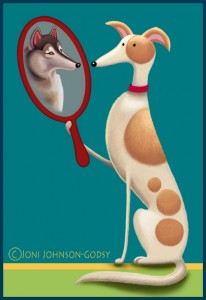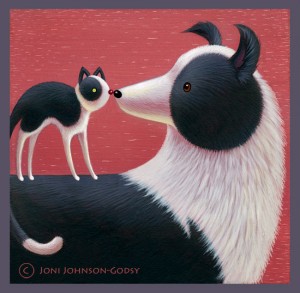As we look at our cuddly dogs who shower us with kisses in the morning, fling themselves upside down for tummy rubs and contently curl up at our feet as we tap away at our computer key boards, it can be difficult to imagine them as “cold blooded killers”. But we often don’t have to look very far to see the heritage of predator in them. Just throw a toy, walk your dog by a squirrel, or have a cat quickly run past and the “animal” inside of Fido will quickly appear.

Like all carnivores, the eyes of a dog are positioned on the front of his head. This is very different from prey animals like deer, rabbits, squirrels and even birds, which have eyes on the sides of their heads so they can see not only what is in front of them, but also what is following behind. A predator must see only what is in front of him, and be able to lock focus and follow quick movement which is what leads him in a chase. People too, are social predators and are very effected by movement. Just look out a window at any scene. It will be the moving objects that attract your eye.
In some dogs this predatory legacy is more prominent than in others. Certain breeds were created upon the very fundamentals of this principle for the benefit of man. Terrier breeds were bred to hunt quick moving vermin that live under ground. It is very difficult to encourage a Jack Russel Terrier to ignore that mouse in the house! Some of the hound breeds too, are especially attracted to movement for this same reason. Herding breeds are bred to notice even the slightest muscle twitch on a cow or sheep so they can control that movement. So a car zooming by on a road or a pet cat running through a house is to them quite “chase worthy”. Guard breeds are bred to notice the slightest movements of human strangers, so they can be at the ready when trouble arises.
It is important when adopting a new dog to take a close look at the other animals you may already have in your house. Not all dogs have strong prey drive. And some dogs just like a good chase. It is the dog who is in true predator mode that can be dangerous to the small animals who already reside in your home. These are also the dogs that are typically the most difficult to rehabilitate. Finding an appropriate balance between your animals during adoption can save a lot of heartache for you later on.

The good news is that many dogs can be trained to leave your other furry little pets alone. Dogs who like to chase movement, but are not wanting to kill as the end product can be most easily modified. This starts with good leadership by you, the pack leader. It is imperative that your dog first views you as Commander and Chief if you are to be successful in modifying this behavior. We can often distract a “chase oriented” dog away from the family cat with a toy or food reward that is better or more fun than chasing that cat.. We can redirect his attention onto something more to our liking by controlling the situation with the dog on a leash. It is important to give a special “reward” for a dog who is learning to ignore the fast movement of the “prey” animal.
It is our responsibility as humans to manage our animals correctly and ensure safety for everyone under our care. In most cases, it is when defined leadership within a home is in question that chaos occurs.